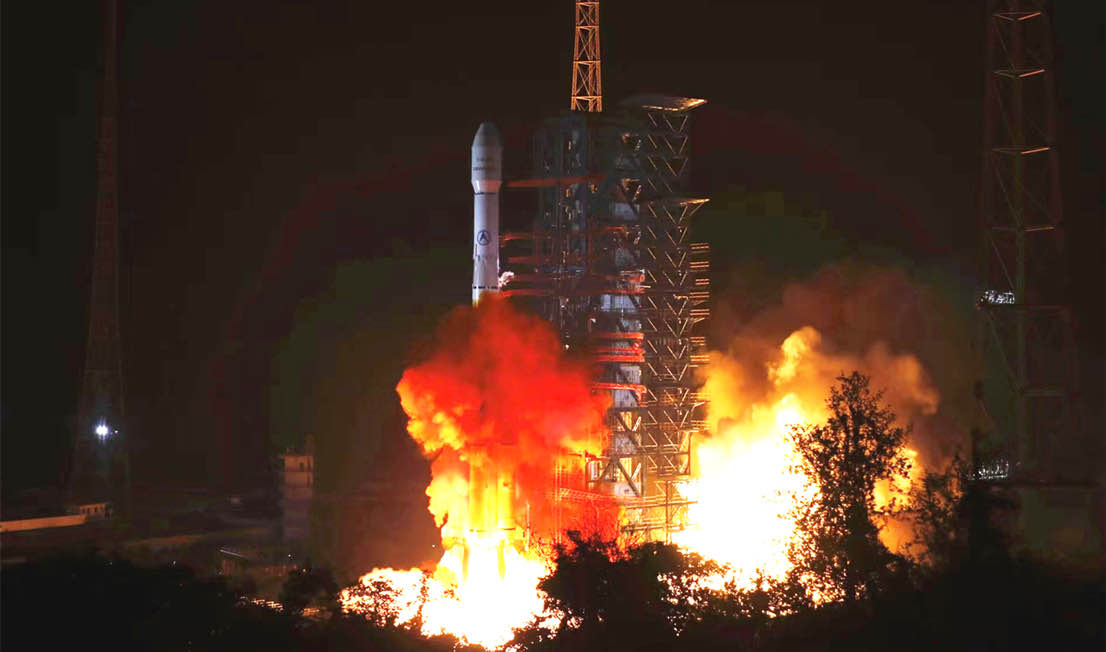
Two Chinese rocket launches hours apart Friday successfully deployed a radio and TV broadcasting spacecraft and an atmospheric environmental monitoring satellite.
The missions from different spaceports lifted off a little more than six hours apart, continuing China’s 2022 launch campaign, a schedule highlighted by planned flights to expand the country’s space station.
A Long March 3B rocket lifted off from the Xichang launch base in Sichuan province at 1200 GMT (8 a.m. EDT; 8 p.m. Beijing time) Friday with the Chinasat 6D, or Zhongxing 6D, communications satellite. The 18-story-tall launcher steered southeast from Xichang, nestled in a hilly region of southwestern China, and shed its four liquid-fueled boosters and core stage about two-and-a-half minutes into the mission.
A second stage and hydrogen-fueled third stage delivered the Chinasat 6D satellite into an elongated geostationary transfer orbit stretching more than 22,000 miles (nearly 36,000 kilometers) above Earth at its highest point, with an inclination of 28.5 degrees to the equator, according to publicly-available U.S. military tracking data.
The China Aerospace Science and Technology Corp., or CASC, declared the launch a “complete success.” CASC is the largest government-run enterprise in the Chinese space industry.
Chinasat 6D was expected to fire its maneuvering engine for a series of burns to reach a circular geostationary orbit some 22,000 miles over the equator, a process that will take several weeks.
The satellite is based on the DFH-4 spacecraft design built by the China Academy of Space Technology, a state-owned company. It will enter service at 125 degrees east longitude for China Satcom, providing high definition television broadcast services, radio transmission services, and emergency communications support. Chinasat 6D will cover users across Southeast Asia and the South China Sea, including island nations, CASC said.
Chinasat 6D, designed for a mission of more than 15 years, will replace the Chinasat 6A satellite launched in 2010.

Six hours after the launch of Chinasat 6D, a Long March 4C rocket took off from the Taiyuan launch base in northern China’s Shanxi province. CASC said the three-stage Long March 4C launched at 1816 GMT (12:16 p.m. EDT) Friday.
The launcher delivered an atmospheric environmental monitoring satellite to a polar, sun-synchronous orbit at an altitude of roughly 425 miles (685 kilometers), U.S. military tracking data indicated.
The satellite, known as DQ-1, will track fine particles, pollutants, greenhouse gases, clouds, and aerosols in the atmosphere, plus land surfaces and water bodies, according to the China National Space Administration — the Chinese space agency — which manages the mission.
The spacecraft’s instruments include an atmospheric detection laser sensor to detect atmospheric carbon dioxide and aerosols, a polarization scanner to measure particulates in the atmosphere, a multi-angle imaging instrument, an ultraviolet hyperspectral atmospheric composition detector, and a wide-field imaging spectrometer, according to CNSA.
Data collected by the DQ-1 satellite will help scientists monitor air pollution and climate change, the Chinese space agency said.
The launches Friday occurred hours before the landing of three Chinese astronauts to wrap up the first six-month crew expedition on the Chinese station. Another trio of astronauts is set to launch to the space station in June, followed by launches of China’s heavy-lift Long March 5B rocket in July and October with two laboratory modules to triple the pressurized living volume of the orbiting research complex.
Email the author.
Follow Stephen Clark on Twitter: @StephenClark1.
from Spaceflight Now https://ift.tt/tCmDSeX
via World Space Info







0 comments:
Post a Comment